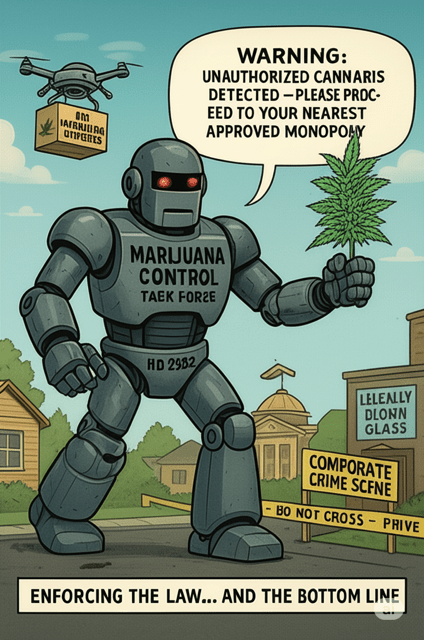The year is 2050. Federal laws never changed and cannabis is still stuck on Schedule I. Sure, Congress passed banking reforms and federal tax measures, but legalization? That never really happened. Just taxation. Somehow, there was plenty of funding for that. Not enough to end prohibition. Almost like the industry kept cannabis locked in its grip by teaming up with the prohibitionists.
In Arizona, the laws that needed to change stayed frozen, while the ones that didn’t need changing got rewritten. Task forces that never should have existed now thrive. The industry controls every sale, CBD, pipes, bongs, nicotine. Instead of expanding, it shrank year after year until only five companies held every license.
It all traces back to the 2030 election cycle, that’s when Big Marijuana bought out the entire Arizona Legislature. House, Senate, both sides of the aisle, it didn’t matter. They poured money into every campaign, winners and losers alike, just to lock down control over cannabis.The following session in 2031, HB 2292: Marijuana Control Task Force, sailed through both chambers and became one of the first bills signed by the governor. One might expect such a task force to target the industry’s mold problem or maybe run a secret shopper program. Instead, HB 2292 diverted Smart and Safe tax revenue to hunt down “illegal competition” which, in practice, meant anything but.
This “independent third-party” task force turned out to be as independent as the Legislature itself. Practically overnight, cannabis was re-criminalized. The few remaining caregivers were wiped out, and real RSO became almost impossible to find.
By 2032, with caregivers gone, corporate cannabis set its sights on the cities. They bankrolled city council races, bypassing both the Legislature and the Voter Protection Act. The payoff? City-level bans on home grow. And with a task force already in place to enforce it, they didn’t just win—they owned the playing field.
From there, the license system locked everything down. Arizona might have had more than a thousand cannabis brands on paper, but real variety was an illusion. Most of those brands didn’t hold their own licenses at all they operated under a few giant manufacturers. These companies handled the cultivation, extraction, packaging, and distribution, while the brands focused on marketing. It was like a cereal factory running multiple “different” brands down the same production line different labels, same source.
After that, it was nothing short of a prohibitionist renaissance. Smoke shops? Gone. Independent glass blowers? Extinct, unless they played ball. Anything even remotely connected to cannabis-pipes, bongs, rolling papers, grinders, CBD could only be sold through one of the state’s tightly controlled cannabis licenses. For glass blowers, getting their work into a dispensary became like trying to land a record deal in the music industry. You needed the right connections, a spotless track record, and usually a chunk of your soul. The dispensaries dictated the terms, the prices, even the designs. Creativity took a back seat to “market-approved” shapes and colors. Independent artistry was replaced with mass-produced imports stamped with corporate logos, and the culture that once fueled the scene was scrubbed clean for “brand image.”
In the name of “public safety,” the industry and the prohibitionists found common ground. What had once been a sprawling, colorful ecosystem of small businesses and makers was corralled into a handful of state-sanctioned storefronts, all guarded by the same gatekeepers who profited most from keeping cannabis rare, expensive, and firmly under their control.
You’d think the state would have issued more licenses just to keep up with the growing population and absorb the overflow from the smoke shops they’d shut down. But no. As I’ve said, the laws that needed to change never did.
The unions scored a win, briefly. But by 2040, there were no workers left to benefit from it. It’s hard to say which came first cultivations turning to automation after water shortages, or dispensaries replacing people to crush union demands. Either way, the result was the same: robots and AI-powered drones ran everything. They planted, trimmed, extracted, even made the edibles.
The craft was gone. No one listened to the plant anymore its terpenes, its subtle personality, its history. Cannabis became just another climate-controlled monocrop, grown indoors for uniformity, stripped of its character and soul.
Which brings us to now, 2050, where just five companies own the entire Arizona cannabis market. They own the Legislature. They own the city councils. With all the money they pour into politics, you’d think they could just produce decent cannabis. But no.
Here in 2050, we settle for a product that barely scrapes by as mids, pay premium prices for it, and stand in lines that stretch for hours just to buy a bong with all the personality of the flower you’re about to pack into it.So instead of cannabis becoming truly mainstream woven into nursing homes, physical rehabilitation programs, and everyday wellness, what we got was nothing but corporate cannabis. The plant never became a tool for healing or community, only a product for shareholders. If only people had understood back then that regulation and taxation were not the same thing as legalization. Maybe the fight wouldn’t have fizzled out. Maybe the grassroots voices wouldn’t have been drowned out by lobbyists. And maybe, just maybe, we wouldn’t be standing here in 2050, looking at an industry that feels more like a chain pharmacy than a culture.


